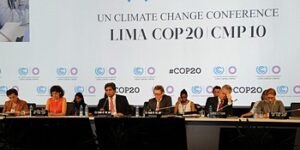
A plenary session at the Lima Climate Change Conference, where fundamental disagreements made it difficult to reach a consensus. Flickr / UNclimatechange
At the heat of debates at COP20 was the scope of Parties’ intended nationally determined contributions (INDCs), which are to form the core commitments in the Paris agreement, and how, if at all, they might be reviewed before the Paris conference. SEI Research Fellow Harro van Asselt, who co-authored a policy brief in the lead-up to COP20 outlining the options for assessing and reviewing INDCs, and presented his analysis at a side-event, answered questions about the Lima outcome.

Q: What happened to the review process for INDCs in the run-up to Paris, and what are the implications?
HvA: On the last day, the text on the so-called ‘ex ante’ review process was watered down significantly. A proposal was on the table for a workshop among Parties at a UNFCCC session in June 2015, but this was deemed unacceptable by the group of like-minded developing countries (LMDCs, including China and India), who argued that there was no basis for such a review in earlier decisions and were not ready to accept a review of INDCs in the absence of a review of available financial support.
In the end, the only ‘review’ that will take place is a synthesis report to be drafted by 1 November 2015 (a month before Paris) by the UNFCCC Secretariat that will see how the pledges submitted by October add up, but will not require follow-up by Parties.
This outcome is significant as there is now no formal process under the UNFCCC for assessing and reviewing the individual contributions of (major) Parties. Even if there was such a formal process, however, it would unlikely change the INDCs of major Parties, as no one was expecting the U.S. or China to change their commitments. Yet the process could help facilitate understanding of the assumptions underlying INDCs and set a benchmark for future reviews under a 2015 agreement. While this does not bode well for future review processes, stronger processes may still be agreed for the Paris agreement. Furthermore, though the lack of an ex ante review is deplorable, I have no doubt that major Parties’ INDCs will be heavily scrutinized by observers and that Parties will informally consult with each other about their commitments.
Q: The Lima decision does not include a requirement that rich countries include financial commitments in their INDCs. Why is this important?
HvA: At present, there is no concrete link between the INDCs and finance, except for finance to prepare them in the first place. This is a significant omission, as the provision of financial support is a crucial precondition for many developing countries. As a result, some developing countries may submit vague or conservative INDCs, if they think they will have to implement them unconditionally, whereas other developing countries may specify that their actions are conditional on support.
Q: Differentiation between developed and developing countries became a vital issue in the last day of the talks. How can this issue be dealt with under a 2015 agreement?
HvA: The UNFCCC distinguishes between Annex I (developed) countries and non-Annex I (developing) countries. I think there is no reason for getting rid of this distinction – and I don’t think it would be politically realistic – but at the same time I also think that this binary distinction should not stand in the way of further differentiation within these groups of countries.
The principle of ‘common but differentiated responsibilities and respective capabilities’ in its true form should allow for further differentiation. Brazil has acknowledged as much, and its suggestion of ‘concentric differentiation’ suggestion is a good way forward, as it provides for more fine-grained differentiation.
Q: The Lima outcome has been heavily criticized, but were there also positive signals?
HvA: I think there are several positive takeaways. Although the decision on INDCs can generally be considered to be weak and vague, it still provides a common way forward for all Parties. Moreover, I think it is important that Parties agreed that INDCs should go beyond ‘current undertakings’, preventing backsliding and establishing a principle for future INDCs. Moreover, although this is not a hard requirement in the Lima decision, it will be interesting to see if Parties will specify why they think their INDCs are ‘fair and ambitious’, as such argumentation will provide an important basis for future assessments and reviews.
A second positive signal concerns non-state and subnational action. Parties agreed to continue so-called ‘technical expert meetings’ and to organize annual high-level forums on climate action. A similar forum this year led to the launch of the NAZCA portal, which showcases the diversity of climate action beyond the UNFCCC. Clearly, non-state and subnational action does not replace the intergovernmental process, or makes up for its lack of ambition and progress, but I think that this increasing acknowledgement by Parties of the ‘all-hands-on-deck’ approach is positive.
Finally, from a procedural perspective, the Presidency of the COP played a very important positive role in bringing Parties close together, showing how important it is to have a well-prepared Presidency.
Design and development by Soapbox.
